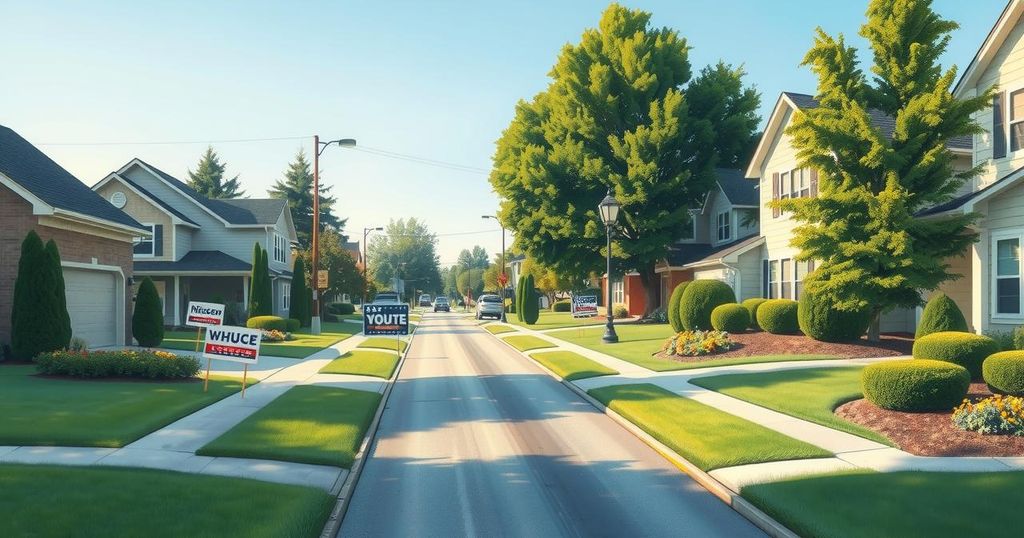America’s Biggest Divide Is the Superpolitical vs. the Exhausted Majority
In the run-up to the U.S. presidential elections, political apathy seems to grip many Americans. Local neighbourhoods, such as Berkeley, once alive with vibrant yard signs, now show a noticeable absence of enthusiasm for presidential candidates. A few cheeky “Vote for Rubber Ducky” signs punctuate the streets, embodying a broader sentiment of fatigue. A recent study reveals that a majority of citizens find themselves utterly exhausted by the current state of political discourse, which not only suggests a crisis but also unveils potential pathways towards healing the divide that separates them from the superpolitical elite.
The Study of the Exhausted Majority More in Common, a nonprofit aimed at bridging the divides, released a pivotal report called “Hidden Tribes” back in 2018. This research unveiled seven distinct political identities among Americans, highlighting that a hefty 67% fall into what they call the ‘exhausted majority.’ These are the folks—worn out by relentless left-right disputes—who often remain silent while the more extremist voices dominate discussions. The study notes that while the political heavyweights engage in a battle of partisanship, these ordinary citizens seem to be opting out altogether, which could either signal disaster or a chance to reshape the political narrative. Yes, amid all the shouting, a quieter and more reasonable middle is waiting for its moment to shine again. The current political climate has led to concerns of a widening gap between the average voter and those on the extremes—often dubbed the ‘superpolitical’ class. According to Stanford political scientist Morris Fiorina, many Americans live their lives with little time or inclination to engage in rigorous political debates. They’re focused on careers, family, and, yes, the occasional recreation. This everyday perspective can, unfortunately, get drowned out as more vocal partisans elbow their way to the front of the political stage. Fiorina suggests that it’s less about a genuine divide among voters, and more about a system that leaves people with limited choices when trying to express their views at the ballot box. Fiorina’s contention is that as political parties have moved towards more extreme ideologies—clearly delineating themselves from one another—voter behaviour remains relatively stable. The environment has essentially given birth to political binaries that do not cater to the moderate average American. For instance, you have parties across the country being bankrolled by out-of-state funds, suggesting that the priorities of constituents might not align with what gets spouted by the party elites. This, undoubtedly, leaves many feeling politically unrepresented and disenchanted.
Political Climate in Berkeley As the countdown to the U.S. presidential election ticks ever closer, political fervour seems to have swamped neighbourhoods across America. In places like Berkeley, where you might usually spot colourful yard signs for a wide array of local and national candidates, the absence of presidential promotional items is striking. Instead, the quirkiness of a few yellow “Vote for Rubber Ducky” signs along University Avenue serves as a rather humourous reminder of how drained many Americans feel about the political landscape. This sentiment isn’t just a local vibe; it’s echoed nationally, where research illustrates a growing discontent among everyday citizens amid the political chaos.
A Majority That Feels Forgotten Beyond the noise, the landscape is populated by what Hawkins defines as the exhausted majority: a diverse group embodying around two-thirds of Americans frustrated with the established political conversation. This segment of the population is not deeply tied to the ideological trenches and rather seeks common ground, yearning for a sense of representation amidst what feels like an endless political tug-of-war. They’re driven by a desire for a functioning government that prioritises the country’s success over party allegiance, and therein lies their strength. While the political system grapples with instability—evident in the oscillation between electoral control—most citizens aren’t party zealots and grow weary of the constant back and forth. Fiorina posits that the current electoral system imposes a binary exposure on the populace, which deprives individuals of the ability to express more moderate views. Many citizens might feel forced to pick sides in a scenario that offers little room for nuance or compromise. This predicament creates a dynamic where ideological extremes cushion their seats while the majority is essentially left on the sidelines feeling neglected. The situation is further exacerbated by the unique political structure of the U.S. Most global democracies operate under a parliamentary system, but here we’re shackled to a complex two-party presidential apparatus, thus encouraging divisive politics and, often, legislative deadlock. Fiorina’s exploration shows that, even if we historically experienced clearer majoritarian governance, the present resembles a political battleground where the infusion of new ideas struggles against the inertia of binary choices. With an electoral cycle every two years, the U.S. sees patterns of institutional control flare and dissipate, oftentimes resulting in gridlock that yields little progress.
The Influence of Superpolitical Groups Diving deeper, Fiorina categorizes those on the extreme ends of the political spectrum as ‘the wings.’ These individuals, while numerically slim, hold enough sway over party platforms to pull them towards more partisan stances—essentially tugging the narrative left and right. This leaves the wider voting populace stuck in the middle, further complicating political discourse. Moreover, the mounting influence of social media and cable news enables echo chambers that contribute to the overall disconnect between those engaged in politics and the broader society. It begs the question of who’s really influencing whom in this convoluted system. The historical perspective is interesting, drawing comparisons to prior eras when America had larger, more heterogeneous parties capable of forging cross-party coalitions. Fiorina argues that the current environment consists of parties that have sorted into solidly liberal and conservative categories, making collaboration a hard road to travel. The rising pressures of political ideologies have transformed what used to be an easier task—building consensus into a high-stakes game of survival among lawmakers. As Fiorina notes, solving issues is now an uphill battle, thanks to the extreme inclinations of both parties driving the discussion.
Looking Ahead at the Election Landscape With all this in mind, it’s clear we’re stepping into a crucial moment in America’s political theatre. Many citizens seem needlessly fatigued, yearning for different dialogue and fresh approaches to longstanding issues. As we witness the flow of intense emotions manifesting at home in our communities, parties might find that they’ve got some serious soul-searching to do. The hope here is that amidst this turbulence, there’s a chance for America’s exhausted majority to rise and reclaim the narrative, demanding a political atmosphere that reflects their ideals instead of diminishing them to caricatures in a deeply polarised world. A revitalisation of the political landscape may well rest on making room for moderation, compromise, and above all, a genuine representation of the American people’s interests.
A Political Landscape in Need of Change As we barrel toward the upcoming election, the outlook appears problematic. Fiorina doesn’t mince words: “This election is shaping up as ugly, with results that may satisfy no true majority.” Even so, there’s a glimmer of hope emerging from the DNC as they lean towards reaching out to this exhausted majority. For instance, the campaign headed by Kamala Harris pursues a middle-ground approach, focusing less on identity politics and more on practical policy discussions aimed at resolving real-world issues—from economic debates to immigration reform. Hawkins notes the stark contrast between Harris’s approach and the more identity-focused strategies adopted by previous candidates such as Obama and Clinton. This strategic pivot could be a significant factor in the election’s outcome, especially if it resonates with moderate voters feeling neglected in the current climate of hyperpartisanship. The focus on pragmatic leadership rather than divisive rhetoric might just plant the seeds for a renewed vibrancy in political participation among the exhausted majority. But will that sufficiency be enough to draw people to the polls? Time will tell, but, crucially, it may spotlight a pathway towards a more involved electorate eager for sensible representation, rather than the exhausting spectacle we’ve come to know.
The situation is a proverbial dance: one step forward, two steps back. The political arena today feels overwhelmingly like the wrong kind of rollercoaster—those endless loops of big swings and stomach-churning drops that leave folks searching for solid ground. How this saga unfolds as election day approaches, remains to be seen, but one thing’s for certain: many voters do not want to be passengers on a rollercoaster, they crave direction. The exhausted majority may soon rediscover its voice and steer the conversation back to what truly matters.
What is meant by the ‘exhausted majority’?
The term ‘exhausted majority’ refers to a majority group of Americans who feel frustrated with the current political debate and are not deeply invested in extreme political ideologies. They are often seeking common ground and compromise.
Who are the superpolitical groups mentioned in the article?
The superpolitical class consists of a relatively small segment of the population that is highly engaged in politics, often driving the narrative and influencing party positions far to the extremes.
Is America really as polarized as it seems?
According to the research, political polarization isn’t as prevalent among all Americans as much as the media portrays. Many Americans lead busy lives and are not overly invested in partisan politics.
What can we expect from the upcoming elections?
The upcoming elections are primed to be contentious. Analysts note that dissatisfaction runs deep, and outcomes may not truly reflect the views of the majority due to entrenched party dynamics.




